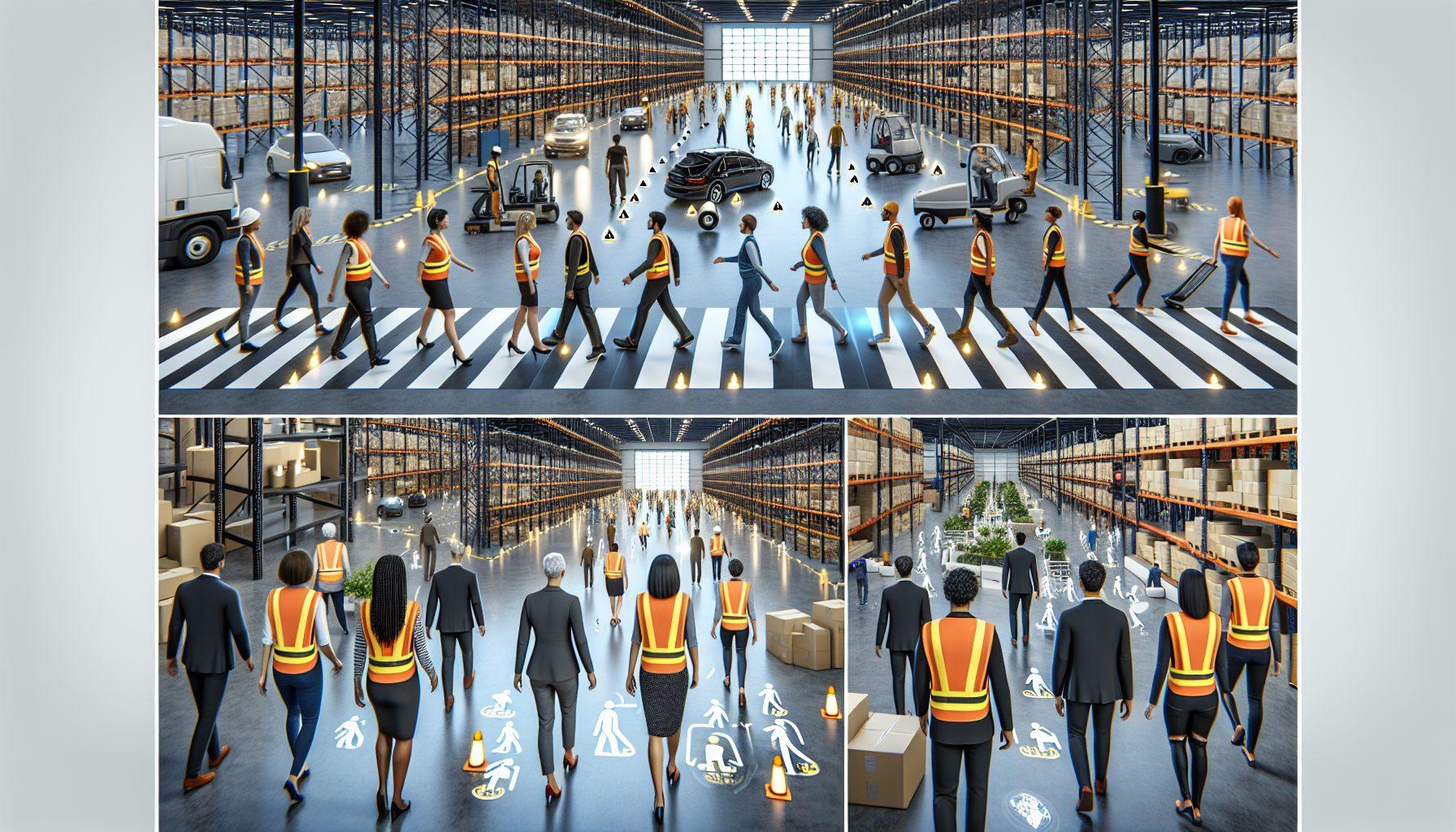Warehouses can be bustling with activity, with forklifts zipping around and workers busy fulfilling orders. In such a fast-paced environment, it’s essential to prioritize safety to prevent accidents and injuries. One effective way to enhance warehouse pedestrian safety is by utilizing visual cues. By incorporating visual cues into the warehouse layout and operations, companies can significantly reduce the risk of accidents and create a safer working environment.
The Power of Visual Cues
Visual cues are visual signals or markers strategically placed within the warehouse to guide pedestrians and alert them to potential hazards. These cues serve as reminders and warnings, helping individuals navigate the warehouse safely by providing clear directions and highlighting dangers.
Here are some key benefits of utilizing visual cues for warehouse pedestrian safety:
- Promote Awareness: Visual cues draw attention to potential hazards, making workers and visitors more aware of their surroundings. This heightened awareness can help prevent accidents by keeping individuals vigilant and cautious.
- Enhance Visibility: Bright and eye-catching visual cues are easily noticeable, even from a distance. By using colors and symbols, these cues can quickly grab attention and effectively communicate important safety information.
- Guide Movement: Visual cues, such as floor markings or directional signage, can help pedestrians navigate the warehouse efficiently. By clearly indicating designated walkways and traffic flow patterns, these cues prevent confusion and reduce the probability of collisions.
- Promote Consistency: Consistency in visual cues is key to creating a safe warehouse environment. By implementing standardized visuals throughout the facility, individuals become accustomed to the cues and can easily recognize and respond to them.
- Improve Communication: Visual cues can also serve as a form of communication between forklift operators and pedestrians. For example, using floor markings to indicate safe zones for pedestrians can help forklift operators be more aware of where pedestrians might be present and take appropriate precautions.
Types of Visual Cues
There are various types of visual cues that companies can implement to enhance warehouse pedestrian safety. Let’s explore some common ones:
- Floor markings: Color-coded floor markings can be used to designate pedestrian walkways, vehicle lanes, and hazardous areas. For example, using yellow lines for pedestrian paths and red lines for no-entry zones can help prevent accidents and ensure a clear separation between pedestrians and forklift traffic.
- Signage: Well-placed signs with clear instructions can effectively communicate safety information. For instance, signs indicating “Stop Look Listen” at intersections or “Watch for Forklifts” near high traffic areas can serve as crucial reminders for pedestrians.
- Reflective tape: Using reflective tape on objects or surfaces can improve visibility. Placing reflective tape on the edges of obstacles, doorways, or corners can make them more apparent, even in low-light conditions.
- Warning signals: Audible and visual warning devices can be installed near areas with potential hazards. These signals can alert pedestrians to be cautious and stay vigilant. For instance, audible alarms near blind corners or flashing lights near loading docks can provide an extra layer of safety.
- Mirrors: Mirrors strategically placed in tight corners or blind spots can help pedestrians see around obstacles and be more aware of their surroundings. Mirrors can also aid forklift operators in spotting pedestrians before making turns or reversing.
In addition to these visual cues, technological advancements have contributed to innovative solutions for warehouse pedestrian safety. One such solution is the implementation of forklift pedestrian detection systems. These systems use a combination of sensors, cameras, and alarms to detect the presence of pedestrians near forklifts and alert operators to potential collisions. HCO Innovations provides a state-of-the-art Forklift Pedestrian Detection System. Find out more about this system here.
Best Practices for Visual Cues Implementation
To ensure the effectiveness of visual cues for warehouse pedestrian safety, companies should follow these best practices:
- Regular Maintenance: Visual cues should be regularly inspected to ensure they remain visible and in good condition. Faded markings or damaged signs should be promptly replaced or repaired.
- Compliance with Regulations: It is crucial to adhere to safety regulations and guidelines specific to the warehouse environment. Factors such as aisle width, signage requirements, and visibility standards should be considered when implementing visual cues.
- Employee Training: Proper training should be provided to all warehouse personnel regarding the significance and meaning of visual cues. Employees should understand the importance of following these cues and be aware of their role in promoting safety.
- Feedback and Evaluation: Regular feedback from employees and evaluation of the effectiveness of visual cues can help identify areas for improvement. This feedback loop ensures that visual cues are continuously optimized for maximum safety.
In conclusion, incorporating visual cues into warehouse operations is a proactive approach to improve pedestrian safety. By using visual cues such as floor markings, signage, reflective tape, warning signals, and mirrors, companies can effectively enhance awareness, guide movement, and reduce the risk of accidents. In addition, advanced technologies like the Forklift Pedestrian Detection System offered by HCO Innovations further contribute to creating a safe warehouse environment. By prioritizing safety and implementing visual cues, companies can demonstrate their commitment to protecting their workforce and promoting a culture of safety within the organization.

